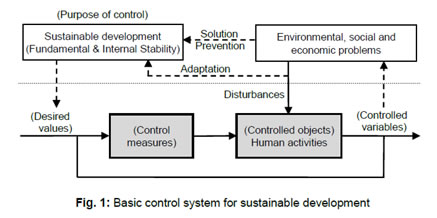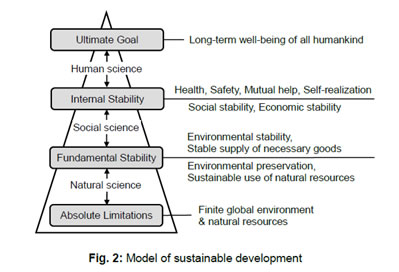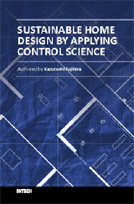Institute of Environmentology, Research and Education for Sustainability or Sustainable Development, Kazutoshi Fujihira
Basic Control System for Sustainable Development
Institute of Environmentology >> Basic Control System for Sustainable Development
In order to tackle tasks by applying the science of control, it is necessary to show a control system in which system components are incorporated. Therefore, we have first demonstrated the basic control system for sustainable development.
In the basic control system for sustainable development (Fig. 1), “controlled objects” are human activities which need to be controlled. “Disturbances” are harmful influences on controlled objects which are caused by environmental, social or economic problems. Examples of the disturbances are damaging influences caused by environmental pollution, floods or landslides resulting from environmental destruction, and various impacts caused by climate change. Moreover, “adaptation” has been added as the route from “disturbances” to “sustainable development.” The reason is that, recently, as climate change has become more serious, adaptation, which means anticipating the harmful influences of climate change and avoiding or minimizing the damage, has become more important. “Controlled variables” are the variables that relate to the human activities and need to be controlled for basically solving or preventing the problems or adapting to disturbances.


“Desired values” are derived from the purpose of control, that is to say, sustainable development. The model of sustainable development (Fig. 2) demonstrates that sustainable development requires both “Fundamental Stability” and “Internal Stability,” in order to accomplish the long-term well-being of all humankind, or ultimate goal, within the finite global environment and natural resources, or absolute limitations [10, 11]. Fundamental Stability means environmental stability and a stable supply of necessary goods; the conditions for Fundamental Stability are environmental preservation and the sustainable use of natural resources. On the other hand, Internal Stability means social and economic stability; the conditions for Internal Stability are health, safety, mutual help and self-realization, which are essential for well-being of humans. The control objective is to adjust the controlled variables to their desired values. Furthermore, the control system requires designing and implementing “control measures,” or measures for achieving the control objective.
Related publications
Sustainable Home Design by Applying Control Science

Written by Fujihira, K., InTech, December 2017
Chapter 3 Basic Schemes: Preparations for Applying Control Science to Sustainable Design
